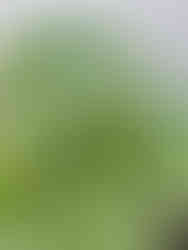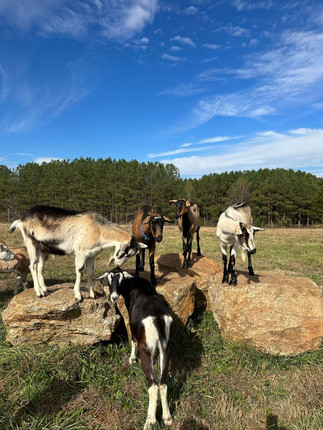Diving into December
- Rosa
- Dec 16, 2022
- 6 min read

Chicken Champs
The chickens have been on our flower garden plot for a little over a month now, and they have made a visible impact. With some help from us people to remove the larger plants, they've done great work clearing the land, eating back the fescue and other weeds. Plus, the whole time they have been adding nitrogen to the soil through their, um, manure.
Unfortunately, the chickens are up against our greatest enemy- Bermuda grass. So we have to help them out in the areas where it's particularly bad using pitchforks, shovels, and hand pulling. There are patches where its underground stems and roots form a dense lattice for half a foot down into the earth. The chickens don't really like eating it, now that it is just this tough, dormant form. However, as we dig it up, we unearth goodies like old seeds and insects for the chickens, so they flock around us as we work. We have to be carefully not to hurt their little toes, but even though that slows us down a little, it's worth the fun (and noisy) companionship.
Removing the Bermuda grass is proving to be a lot of labor, but as we sink our shovels into the earth, we are able to observe an encouraging pattern. Across the whole footprint of the old flower garden, there is a solid layer of thick, healthy soil - even in the places that used to be paths. In our paths we use wood chips and leaves, which do decay slowly over time. But there are essentially no woodchips to be found at all. We were worried that the chickens would mix path chips into the soil for our future garden beds, but we don't have to worry about that anymore.
I believe that this uninterrupted layer of soil is due to the weed pressure we faced last summer and fall. In this garden the paths became covered in a thick layer of 'weeds'. Although, a weed is just a plant growing in a place you don't want it, so maybe the plants weren't completely weeds, because it turns out they helped us build soil out of woodchips. The incredible relationship plants and their roots have with the complex life in soil is a fascinating phenomena, and invaluable to the way nature builds and maintains soil. Now, when the chickens move off the garden, we'll be primed to build healthy garden beds.
Even the Bermuda grass was a part of this beneficial process, which is a thought I try to remember as we put in the time to remove cart after cart of the vivacious grass. Going forward, we'll attempt to keep the weeds under control, to facilitate easier planting and limit competition with our crop plants. But this is a prescient reminder of a key no-till gardening idea. Time and organic matter are important, but ultimately, plants in the ground is the very best way to build healthy soil. We mimic this plant coverage with methods like close succession planting and cover cropping, which we plan to use even more next year.
Here is Bagheera walking down one of our flower garden paths last summer, and a handful of soil from underneath the sedge (one of our main 'weeds' in this garden last year).
Old Houses and New Leaves
Speaking of organic materials, one of our most valuable ones has started coming to the farm- leaves. The piles of leaves we receive this fall will carry us through next year. We use them primarily to cover beds and build soil. They are a source of carbon and nitrogen, as well as microbes, insects, and fungi. The chickens love to forage in them, and after they move off their current run, we'll put them into a new one with a whole lot of leaves for them to scratch down into soil.
In fact, the chickens have already made a whole new garden space for us using this method.
One of the pens the chickens were in before they moved started out as a giant pile of leaves - however big you're thinking, it was bigger. Over the course of about a year, they broke the leaves down into soil.
Now that space will become a garden in the spring. The fence that kept the chickens in and predators out will now keep the plants in and the deer out. This week, we removed the tarp on the cattle panel roost house, and we'll remove the roosts too. In the spring, the cattle panels will become a trellis for veggies like pole beans and cucumbers.
We laid the tarps out on the ground to protect the soil and smother the little weeds that are starting to grow. These harmless little sprouts are from the chicken scratch seeds that the hens never ate.
Frosty Veggies
Our lettuce, kale, collards, and beets are still alive and producing. We harvest about once a week, as the plants currently grow a lot slower than they would in warmer weather. We harvest rain or shine, and in the SC winter, that mostly means rain.
A couple weeks ago one of the beds of kale did get hit pretty hard by frost. (The other bed of kale was mostly fine; although they are in different gardens, they were both under covers, so I don't know what happened!). In the effected bed, about 70 percent of the leaves got 'burnt' by the frost. I decided to cut them off since they would no longer be good to eat, and I didn't want the kale putting it's energy into doomed leaves. Since then it's started to bounce back. That's the way frost tolerant plants work; even if individual leaves get hurt, the plant survives.
The onions I started in the fall are bulking up, which is exciting. The sowing of onions I did later into the fall only half germinated. This is supposed to be two rows of onions, but one type decided that it didn't get enough warm days under its belt to sprout. I'll have to plant more in the spring.
Flower Check-in
The flowers are alright! In the last blog, I was worrying that the overwintering flowers would prematurely bloom, but the weather has been just cold enough that they have mostly stalled in their growing (like we want them to). The snapdragons are quite big, but they still fit under the row covers, so for now, all is well.
Indoor Projects
A lot of our work over the past month has gone into organizing our work spaces for next year. As our business grows and evolves, we need a bit more room. We reorganized the attic where we dry flowers for wreaths, and the new space allowed us to move some long-term supplies, like flower vases, out of our main work area.
Next, we gave our work area a thorough winter cleaning, including mopping the floors (plus scrubbing, hence the broom). Then we put back both the prior and new shelves and tables, working towards an efficient space that can accommodate the many functions we need it to do. We still have some things to do, but I can't wait to test the new system when it's completely done and ready for spring.
Hardy Herd
With proper winter on its way, our herd continues rotating through their pastures. While they're still able to graze and browse, the grass has put a lot of its nutrients down into its roots for winter, so we supplement their diet with hay and a grain mixture. If our donkey Gnocchi doesn't get his daily snack on time, he gets loud and grumpy, which is very relatable.
Winter Worries and Wonders
In the chilly stretch of winter it is often hard to tell what to prioritize, because many things are long-term and won't come to fruition until early spring, and because at the same time, everything seems pressingly important. But our plants and soil and leaves and fungi offer a good reminder - growth requires complexity. It isn't simple, or straightforward, or fast paced. It takes time, and work, and community. So thanks to everyone who continues to support us as we work to grow!

At the end here, I wanted to let you know, we now have a newsletter! You can subscribe on the front page of our website by simply entering your email. Then we'll let you know about new blog posts, produce and flower availability, markets and other events, and more. Thanks to everyone who's subscribed so far!
And thanks for reading,
-Lillian










































































Comments